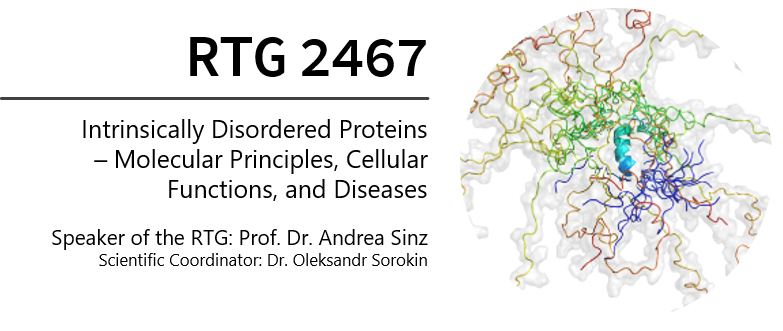
studied Biology at the University of Athens, Greece, from 2002 to 2008, where he did his structural biology project in the laboratory of Prof. Stavros Hamodrakas. He performed his PhD work in the field of computational structural biology at the Bijvoet Center for Biomolecular Research, Utrecht, The Netherlands, and obtained his PhD in 2012 under the supervision of Prof. Alexandre Bonvin from the Chemistry Department of Utrecht University. In 2013, he moved to EMBL-Heidelberg to work with Dr. Anne-Claude Gavin and Dr. Martin Beck in the field of structural proteomics with a focus on cryo-electron microscopy. Since August 2018 he is a group leader and Junior Professor at the interdisciplinary research centre ZIK HALOmem at the MLU. His research project focuses on the structural modeling of highly flexible protein-protein interactions using various sources of experimental data (e.g. XL-MS, cryo-EM) to drive the modeling procedure.
Project within the RTG
Decoding the intrinsically disordered regions of endogenous metabolic complexes implicated in disease
Essential metabolic functions are orchestrated by higher-order protein-protein interactions, which are brought in proximity via various flexible scaffolds, including IDRs (Kastritis & Gavin, 2018). In particular, large metabolic complexes (metabolons) have extensive unstructured regions, which might be up to 60% for some of their subunits, e.g., the E3-binding protein (E3BP) of the pyruvate dehydrogenase complex (PDHc) (Skalidis, Tüting, & Kastritis, 2020). This large amount of disorder is important for their function, especially in regulating the availability of the metabolites, which are of paramount importance to understanding diseases like obesity or insulin resistance (Skalidis, Tüting, & Kastritis, 2020). However, it is unknown how this disorder structurally regulates and organizes the interacting proteins for efficient metabolic function. This is why during the first funding period we aimed first to understand the overall architecture of metabolons by extracting their endogenous cellular states without the need for heterologous expression or harsh purification methods (Kyrilis et al., 2021). Our integrative methods could define architectural models of PDHc and of fatty acid synthase (FAS), but with limited insights into the structural effects of disorder (Skalidis et al., 2022; Kyrilis et al., 2021; Tüting et al., 2021). The knowledge gained on the architecture of metabolons derived during the first funding period will be developed by analyzing the effects of disorder on those metabolons. We will systematically investigate the effects of manifested disorder in primary eukaryotic metabolons and visualize their conformational changes upon perturbation with known ligands – which has not been previously explored.
Literature references
Website: https://www.halomem.de/en/research-group-kastritis/#forschung
